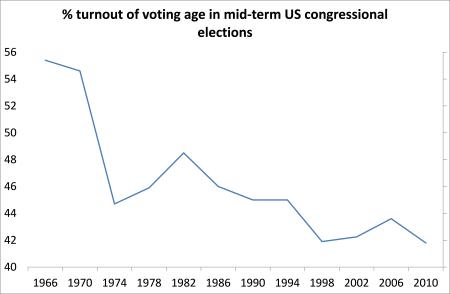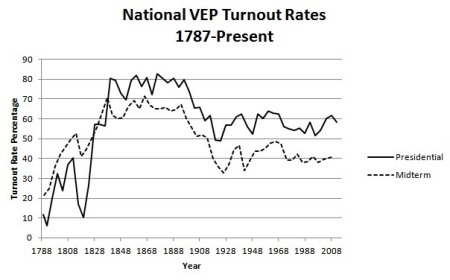Who won the US congress mid-term elections? – the no vote party again
by Michael Roberts
Who won the elections? The Republicans! Well, yes. But the real
winners were yet again the no vote party. We don’t yet have the turnout
of voters for the 2014 mid-term Congressional elections, but it is
probably around just 40% of those of voting age.

That means that 60% of adult Americans did not reckon that it mattered who won. A plague on both your houses – Republican or Democrat; Senate or House – that was their’ cry. This is the real message of the election. For most voters the failure of the Obama administration to restore the incomes of average Americans since the end of Great Recession in 2009 is only matched by the incompetence and downright complacency of the previous Bush administration to see the slump coming and do anything about it, except to bail out the bankers and other crooks who triggered it.
There has been a steady disillusionment with their ‘democratic’ representatives for several decades. Back in the 1960 and 1970s, more than 55% of potential voters turned out in the mid-term elections. In 2010, despite new technology, better regristration and postal voting, that percentage reached a record low of 41%. If we just consider those eligible to vote and exclude ‘non-citizens’ and prisoners, there has been a similar fall in voting shares, in both presidential and congressional elections.

Despite the optimistic noises from the media of a ‘high turnout’ in some areas, I reckon that the 2014 election is likely to reveal a new low, or something close. This will be especially so in the strong Democratic states like California and New York (36%), where working-class disillusionment with Obama’s compliance with the bankers and the rich, while living standards stagnate or even decline, has been strongest – although Republican Arizona polled just 36%.
The growing strength of the ‘no party’ is not unique to US congressional elections. It has been the same in presidential elections (see my post, http://thenextrecession.wordpress.com/2012/11/07/us-election-no-gold-at-the-end-of-the-rainbow/). And it has been the same in elections in all the major capitalist economies, from the UK in 2010 when the Conservatives took office with the lowest share of the vote for a governing party ever to Germany in 2012
(http://thenextrecession.wordpress.com/2013/09/22/german-capitalism-a-success-story/) and Japan in 2012
(http://thenextrecession.wordpress.com/2012/12/16/japan-election-lowest-turnout-since-records-began/) with Europe in 2014
(http://thenextrecession.wordpress.com/2014/05/26/euro-blues/).
The ‘democratic deficit’ gets wider.

That means that 60% of adult Americans did not reckon that it mattered who won. A plague on both your houses – Republican or Democrat; Senate or House – that was their’ cry. This is the real message of the election. For most voters the failure of the Obama administration to restore the incomes of average Americans since the end of Great Recession in 2009 is only matched by the incompetence and downright complacency of the previous Bush administration to see the slump coming and do anything about it, except to bail out the bankers and other crooks who triggered it.
There has been a steady disillusionment with their ‘democratic’ representatives for several decades. Back in the 1960 and 1970s, more than 55% of potential voters turned out in the mid-term elections. In 2010, despite new technology, better regristration and postal voting, that percentage reached a record low of 41%. If we just consider those eligible to vote and exclude ‘non-citizens’ and prisoners, there has been a similar fall in voting shares, in both presidential and congressional elections.

Despite the optimistic noises from the media of a ‘high turnout’ in some areas, I reckon that the 2014 election is likely to reveal a new low, or something close. This will be especially so in the strong Democratic states like California and New York (36%), where working-class disillusionment with Obama’s compliance with the bankers and the rich, while living standards stagnate or even decline, has been strongest – although Republican Arizona polled just 36%.
The growing strength of the ‘no party’ is not unique to US congressional elections. It has been the same in presidential elections (see my post, http://thenextrecession.wordpress.com/2012/11/07/us-election-no-gold-at-the-end-of-the-rainbow/). And it has been the same in elections in all the major capitalist economies, from the UK in 2010 when the Conservatives took office with the lowest share of the vote for a governing party ever to Germany in 2012
(http://thenextrecession.wordpress.com/2013/09/22/german-capitalism-a-success-story/) and Japan in 2012
(http://thenextrecession.wordpress.com/2012/12/16/japan-election-lowest-turnout-since-records-began/) with Europe in 2014
(http://thenextrecession.wordpress.com/2014/05/26/euro-blues/).
The ‘democratic deficit’ gets wider.
No comments:
Post a Comment